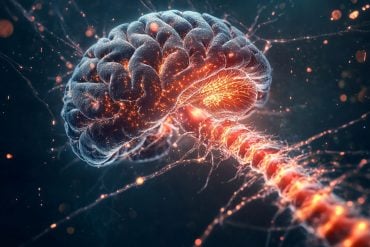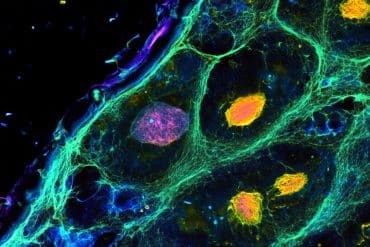Summary: Researchers discovered that oral contraceptives may thin the ventromedial prefrontal cortex (vmPFC) in women, potentially influencing emotion regulation, especially fear responses.
The study examined both current and former users of combined oral contraceptives (COCs), finding that the cortical thinning appears to be reversible after discontinuing use.
The findings suggest that COCs might pose a risk factor for emotion regulation issues during active use, but further research is needed to explore long-term impacts, especially in adolescents whose brain development may be sensitive to hormonal interventions.
Key Facts:
- Women currently using COCs showed a thinner vmPFC compared to men, suggesting potential emotion regulation issues during use.
- The study suggests that the impact of COC use on brain anatomy may be reversible after discontinuation, indicating no lasting anatomical effects.
- Further research is needed to understand the potential lasting effects of COCs, especially concerning the age of onset and duration of use.
Source: Frontiers
More than 150 million women worldwide use oral contraceptives. Combined OCs (COCs), made up of synthetic hormones, are the most common type. Sex hormones are known to modulate the brain network involved in fear processes.
Now a team of researchers in Canada has investigated current and lasting effects of COC use, as well as the role of body-produced and synthetic sex hormones on fear-related brain regions, the neural circuitry via which fear is processed in the brain.
“In our study, we show that healthy women currently using COCs had a thinner ventromedial prefrontal cortex than men,” said Alexandra Brouillard, a researcher at Université du Québec à Montréal and first author of the study published in Frontiers in Endocrinology.
“This part of the prefrontal cortex is thought to sustain emotion regulation, such as decreasing fear signals in the context of a safe situation. Our result may represent a mechanism by which COCs could impair emotion regulation in women.”
Emotion regulation and contraceptives
“When prescribed COCs, girls and women are informed of various physical side effects, for example that the hormones they will be taking will abolish their menstrual cycle and prevent ovulation,” Brouillard explained.
However, the effects of sex hormones on brain development, which continues into early adulthood, are rarely addressed. Considering how widespread COC use is, it is important to better understand its current and long-term effects on brain anatomy and emotional regulation, the researchers said.
The team recruited women who were currently using COCs; women who used COCs previously but did not at the time of the study; women who never used any form of hormonal contraception; and men.
Comparing these groups allowed the researchers to see if COC use was associate with current or long-term morphologic alterations as well as to detect sex differences, since it is established that women are more susceptible to experience anxiety and stress-related disorders than men.
“As we report reduced cortical thickness of the ventromedial prefrontal cortex in COC users compared to men, our result suggests that COCs may confer a risk factor for emotion regulation deficits during their current use,” Brouillard said.
The impacts of COC use, however, may be reversible once intake is discontinued, the researchers said. Given that the vmPFC effect found in current users was not observed in past users, the findings did not support lasting anatomical effects of COC use. This, the researchers wrote, will need to be confirmed in further studies.
Much to learn
There is still much to learn when it comes to women’s brains and how they are impacted by COC use. For example, Brouillard and team are currently investigating the impact of age of onset and duration of use to delve further into the potential lasting effects of COCs.
Given that many teenage girls start using COCs during adolescence, a sensitive period in brain development, user age might also impact reversibility.
Pointing to limitations in their study, the scientists said that no causal relationship can be implied between COC use and brain morphology and that generalization of their results to a general population may be limited.
The researchers also cautioned that drawing conclusion from anatomical findings to behavioral and psychological impact is not possible at this point.
“The objective of our work is not to counter the use of COCs, but it is important to be aware that the pill can have an effect on the brain. Our aim is to increase scientific interest in women’s health and raise awareness about early prescription of COCs and brain development, a highly unknown topic,” concluded Brouillard.
About this neuroscience and psychology research news
Author: Deborah Pirchner
Source: Frontiers
Contact: Deborah Pirchner – Frontiers
Image: The image is credited to Neuroscience News
Original Research: Open access.
“Morphologic Alterations of the Fear Circuitry: The Role of Sex Hormones and Oral Contraceptives” by Alexandra Brouillard et al. Frontiers in Endocrinology
Abstract
Morphologic Alterations of the Fear Circuitry: The Role of Sex Hormones and Oral Contraceptives
Background: Endogenous sex hormones and oral contraceptives (OCs) have been shown to influence key regions implicated in fear processing. While OC use has been found to impact brain morphology, methodological challenges remain to be addressed, such as avoiding selection bias between OC users and non-users, as well as examining potential lasting effects of OC intake.
Objective: We investigated the current and lasting effects of OC use, as well as the interplay between the current hormonal milieu and history of hormonal contraception use on structural correlates of the fear circuitry. We also examined the role of endogenous and exogenous sex hormones within this network.
Methods: We recruited healthy adults aged 23-35 who identified as women currently using (n = 62) or having used (n = 37) solely combined OCs, women who never used any hormonal contraceptives (n = 40), or men (n = 41). Salivary endogenous sex hormones and current users’ salivary ethinyl estradiol (EE) were assessed using liquid chromatography – tandem mass spectrometry. Using structural magnetic resonance imaging, we extracted surface-based gray matter volumes (GMVs) and cortical thickness (CT) for regions of interest of the fear circuitry. Exploratory whole-brain analyses were conducted with surface-based and voxel-based morphometry methods.
Results: Compared to men, all three groups of women exhibited a larger GMV of the dorsal anterior cingulate cortex, while only current users showed a thinner ventromedial prefrontal cortex. Irrespective of the menstrual cycle phase, never users exhibited a thicker right anterior insular cortex than past users. While associations with endogenous sex hormones remain unclear, we showed that EE dosage in current users had a greater influence on brain anatomy compared to salivary EE levels and progestin androgenicity, with lower doses being associated with smaller cortical GMVs.
Discussion: Our results highlight a sex difference for the dorsal anterior cingulate cortex GMV (a fear-promoting region), as well as a reduced CT of the ventromedial prefrontal cortex (a fear-inhibiting region) specific to current OC use. Precisely, this finding was driven by lower EE doses. These findings may represent structural vulnerabilities to anxiety and stress-related disorders. We showed little evidence of durable anatomical effects, suggesting that OC intake can (reversibly) affect fear-related brain morphology.







